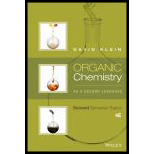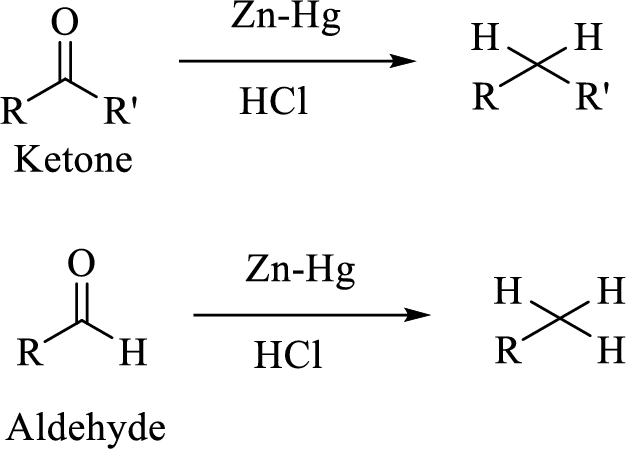
Organic Chemistry As a Second Language: Second Semester Topics
4th Edition
ISBN: 9781119110651
Author: David R. Klein
Publisher: WILEY
expand_more
expand_more
format_list_bulleted
Question
Chapter 4.4, Problem 4.27P
Interpretation Introduction
Interpretation:
The reagents required to achieve the given transition has to be identified.
Concept Introduction:
Friedel-Crafts Acylation: This Lewis acid-catalyzed electrophilic
The reduction of
The reaction can be represented as follows,

Expert Solution & Answer
Want to see the full answer?
Check out a sample textbook solution
Students have asked these similar questions
list the reagents that are needed to carry out in these reactions
Fill in the missing reagents and “key intermediate” in each transformation below:
Determine a stepwise mechanism for the following reaction that illustrates why two substitution
products are formed. Explain why 1-bromohex-2-ene reacts rapidly with a weak nucleophile (CH3OH)
under Syl reaction conditions, even though it is a 1° alkyl halide.
1-bromohex-2-ene
Part 1:
Br
CH₂OH
The first step in the reaction proceeds according to which mechanism?
CH₂CH₂CH₂CH=CHCH₂ + CH₂OH
CH₂CH₂CH₂CH:
Part 2:
Br
CHCH₂
Draw the missing resonance contributor.
OCH3 +
CH3CH₂CH₂CH=CHCH₂
CH3CH₂CH₂CH=CH-CH₂ + Br
Br
OCH 3
H₂CH₂CH₂CH=CH₂
view structure
+
+ Br
HBr
X
Chapter 4 Solutions
Organic Chemistry As a Second Language: Second Semester Topics
Ch. 4.1 - Consider the following reaction, in which an...Ch. 4.1 - Prob. 4.3PCh. 4.1 - Aromatic rings will also undergo iodination when...Ch. 4.2 - In each of the following cases, identify the...Ch. 4.2 - In each of the following cases, identify the...Ch. 4.2 - In each of the following cases, identify the...Ch. 4.3 - Prob. 4.10PCh. 4.3 - Prob. 4.11PCh. 4.3 - Prob. 4.12PCh. 4.3 - Prob. 4.13P
Ch. 4.3 - Prob. 4.14PCh. 4.3 - Predict the products of the following reaction.Ch. 4.3 - Prob. 4.16PCh. 4.3 - Prob. 4.17PCh. 4.4 - Identify the reagents you would use to achieve...Ch. 4.4 - Identify the reagents you would use to achieve...Ch. 4.4 - Identify the reagents you would use to achieve...Ch. 4.4 - Identify the reagents you would use to achieve...Ch. 4.4 - fill in the reagents you would use for the...Ch. 4.4 - fill in the reagents you would use for the...Ch. 4.4 - fill in the reagents you would use for the...Ch. 4.4 - fill in the reagents you would use for the...Ch. 4.4 - Prob. 4.27PCh. 4.4 - Prob. 4.28PCh. 4.4 - And now, for a challenging problem, try to draw...Ch. 4.6 - Prob. 4.31PCh. 4.6 - Prob. 4.32PCh. 4.6 - Prob. 4.33PCh. 4.6 - Prob. 4.34PCh. 4.6 - Prob. 4.35PCh. 4.6 - Prob. 4.36PCh. 4.6 - Prob. 4.37PCh. 4.6 - Prob. 4.40PCh. 4.6 - Prob. 4.41PCh. 4.6 - Predict the products for each of the following...Ch. 4.6 - Predict the products for each of the following...Ch. 4.6 - Predict the products for each of the following...Ch. 4.6 - Predict the products for each of the following...Ch. 4.6 - Prob. 4.47PCh. 4.6 - Prob. 4.48PCh. 4.6 - Prob. 4.49PCh. 4.6 - Prob. 4.50PCh. 4.6 - Prob. 4.51PCh. 4.6 - Prob. 4.52PCh. 4.6 - Prob. 4.53PCh. 4.6 - Prob. 4.54PCh. 4.6 - Prob. 4.55PCh. 4.6 - Prob. 4.56PCh. 4.7 - Prob. 4.58PCh. 4.7 - Prob. 4.59PCh. 4.7 - Prob. 4.60PCh. 4.7 - Prob. 4.61PCh. 4.7 - Prob. 4.62PCh. 4.7 - Prob. 4.63PCh. 4.7 - Prob. 4.64PCh. 4.7 - Prob. 4.65PCh. 4.7 - Prob. 4.66PCh. 4.7 - Prob. 4.67PCh. 4.7 - Can you explain why the following group is a...Ch. 4.7 - Prob. 4.70PCh. 4.7 - Prob. 4.71PCh. 4.7 - Prob. 4.72PCh. 4.7 - Prob. 4.73PCh. 4.7 - Prob. 4.74PCh. 4.7 - Prob. 4.76PCh. 4.7 - Prob. 4.77PCh. 4.7 - Prob. 4.78PCh. 4.7 - Prob. 4.79PCh. 4.8 - Propose an efficient synthesis for each of the...Ch. 4.8 - Propose an efficient synthesis for each of the...Ch. 4.8 - Propose an efficient synthesis for each of the...Ch. 4.8 - Propose an efficient synthesis for each of the...Ch. 4.8 - Propose an efficient synthesis for each of the...Ch. 4.8 - Prob. 4.87PCh. 4.8 - Prob. 4.88PCh. 4.8 - Prob. 4.89PCh. 4.8 - Prob. 4.90PCh. 4.8 - Prob. 4.91PCh. 4.8 - Prob. 4.92PCh. 4.9 - Prob. 4.94PCh. 4.9 - Prob. 4.95PCh. 4.9 - Prob. 4.96PCh. 4.9 - Prob. 4.97PCh. 4.9 - Prob. 4.98PCh. 4.9 - Prob. 4.99PCh. 4.9 - Prob. 4.100PCh. 4.9 - Prob. 4.101PCh. 4.9 - Prob. 4.102P
Knowledge Booster
Similar questions
- Each of the following conversions requires more than one step, and some reactions studied in previous chapters may be needed. Show the reagents you would use and draw structural formulas for intermediate compounds formed in each conversion. a. CH2=CH2CH3CH2OCH2CH3 b. c. d.arrow_forwardUsing your reaction roadmap as a guide, show how to convert the starting trans-alkene to the cis-alkene in high yield. Show all intermediate molecules synthesized along the way.arrow_forwardUsing cis- and trans-hex-3-ene, demonstrate that the addition of HCl is not a stereospecific reaction. Draw the structure of the stereoisomers formed from each alkene.arrow_forward
- Using your reaction roadmap as a guide, show how to convert cyclohexane into racemic 3-bromocyclohexene. Show all reagents and all molecules synthesized along the way. Br Br 3-Bromocyclohexene (racemic) Cyclohexanearrow_forwardTwo cations are possible when 1-butene reacts with acid and water. When 1-butyne reacts with H+ two cations are also possible. Draw them. Based on what you know about alkenes, which cation is more stable? Draw the carbonyl containing products from each enol. Which product would you predict to be favored? Why? Draw the two enols which form from each cation.arrow_forwardUsing your reaction roadmap as a guide, show how to convert cyclohexane into hexanedial. Show all reagents and all molecules synthesized along the way.arrow_forward
- Another important pattern in organic synthesis is the construction of CC bonds. Using your reaction roadmap as a guide, show how to convert propane into hex-1-en-4-yne. You must use propane as the source of all of the carbon atoms in the hex-1-en-4-yne product. Show all reagents needed and all molecules synthesized along the way.arrow_forwardUsing your reaction roadmap as a guide, show how to convert acetylene and bromoethane into 1-butene. All of the carbon atoms of the target molecule must be derived from the given starting materials. Show all intermediate molecules synthesized along the way.arrow_forwardUsing cis- and trans-hex-3-ene, demonstrate that the addition of HCl is not a stereospecic reaction. Draw the structure of the stereoisomers formed from each alkene.arrow_forward
- Show how the product formed as a result of the reaction can be synthesized using the starting materials given below. Any reagent needed can be used and you may need more than one step. c) HO, al OH d) b) Онarrow_forwardGive the reagents needed to complete each transformationarrow_forwardWhat are the correct reaction conditions for the following transformation?arrow_forward
arrow_back_ios
SEE MORE QUESTIONS
arrow_forward_ios
Recommended textbooks for you
 Chemistry for Today: General, Organic, and Bioche...ChemistryISBN:9781305960060Author:Spencer L. Seager, Michael R. Slabaugh, Maren S. HansenPublisher:Cengage Learning
Chemistry for Today: General, Organic, and Bioche...ChemistryISBN:9781305960060Author:Spencer L. Seager, Michael R. Slabaugh, Maren S. HansenPublisher:Cengage Learning Organic ChemistryChemistryISBN:9781305580350Author:William H. Brown, Brent L. Iverson, Eric Anslyn, Christopher S. FootePublisher:Cengage Learning
Organic ChemistryChemistryISBN:9781305580350Author:William H. Brown, Brent L. Iverson, Eric Anslyn, Christopher S. FootePublisher:Cengage Learning

Chemistry for Today: General, Organic, and Bioche...
Chemistry
ISBN:9781305960060
Author:Spencer L. Seager, Michael R. Slabaugh, Maren S. Hansen
Publisher:Cengage Learning

Organic Chemistry
Chemistry
ISBN:9781305580350
Author:William H. Brown, Brent L. Iverson, Eric Anslyn, Christopher S. Foote
Publisher:Cengage Learning